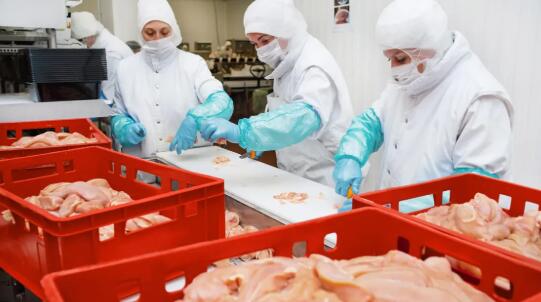In an effort to reduce greenhouse gas emissions from livestock farming, local experts and startups are increasingly using lab-grown meat as India’s meat consumption rises. Cultured meat, commonly referred to as lab grown meat, has gained popularity in the recent years. It is made by culturing animal cells in a laboratory. Nearly 77 percent of Indians consume fish, poultry, and other meats, as per the data from the Ministry of Health and Family Welfare’s National Family Health Survey 5.
According to the survey, 71 percent of women and 83 percent of men do not follow a vegetarian diet. Additionally, India’s appetite for meat is growing as its population continues to grow. Approximately 3.96 million tonnes of chicken were consumed in India in 2020 alone, making it the most sought-after meat among Indians, according to data from the Organization for Economic Co-operation and Development. Subsequently, approximately 1.05, 0.72, and 0.3 million tonnes of buffalo, sheep, and pork were consumed in the same year. India’s increased consumption of meat has resulted in higher emissions of greenhouse gases, particularly carbon dioxide, methane, and nitrous oxide—all of which are significant causes of global warming. A joint report from the Vasudha and Shakti foundations claims that more than 200 million tons of CO2 are released into the atmosphere each year as a result of Indian livestock.
Currently scientists and researchers are looking for alternate protein sources, and culture meat is one of them. In order to further ‘clean’ meat technologies and bring regulators and start-ups together under one roof, the animal advocacy group Humane Society International and the Centre for Cellular and Molecular Biology (CCMB) in Hyderabad formally partnered in 2019. CCMB director Rakesh Mishra stated at the project’s inception that “while technology exists to multiply literally any type of cell, including mammalian cells, the scaling up of the same in an economically affordable manner as a meat substitute remains a major challenge.” It is anticipated that the project, the first of its kind to be sponsored by the government, will produce its first lab-grown meat by 2025.
Cultured meat is a substitute for meat from live animals and is also frequently referred to as lab-grown meat, cell-based meat, and slaughter-free meat. Genuine animal flesh, including shellfish and organ meats, are produced by directly cultivating animal cells. ICAR-Central Institute of Fisheries Education (Mumbai) and The Good Food Institute (GFI) India have also partnered to create the country’s first Smart Protein Innovation Hub on Cultivated Seafood.
Some experts point out that one advantage of this type of manufacturing is that it eliminates the need to farm and raise animals for food. Furthermore, the sensory and nutritional characteristics of traditional meat can be faithfully replicated because the cell types in cultured meat are identical to or nearly identical to those found in animal tissues.
LAB GROWN MEAT VS. CONVENTIONAL MEAT
According to Akshay Bhat, a sci-tech specialist at GFI India, animal agriculture is responsible for three-quarters of agricultural greenhouse gas emissions, or 14.5% of global emissions, making it the single biggest contributor to the ecological and climate crisis. It should be noted that this number exceeds the sum of all modes of transportation. Official statistics show that 78 percent of India’s 24 million tonnes of methane emissions come from livestock.
The use of fertilizers, the expansion of livestock farms, and the intensive nature of the production process have all been connected to this increase in emissions. Additionally, it is claimed that, for a number of environmental indicators, cultivated meat has the potential to have a substantially smaller environmental impact than conventional meat. When compared to conventional meat production, it was discovered that cultivated meat production results in 92% less global warming and 93% less air pollution.
Furthermore, compared to conventional meat, lab-grown meat companies use up to 95% less land and 78% less water during production when renewable energy is utilized. Additionally, meat sourced directly from chicken cells will reduce land use by 63% and global warming by 17%.
POTENTIAL CHALLENGES
India is still in the early stage of producing lab-grown meat. The development of cultured meat technology may be aided by India’s booming startup ecosystem and well-known biotechnology sector, according to Ashwin Bhadri, CEO of Equinox Labs, a food, water, and air testing lab in the nation. He also stated that the process of producing cultured meat entails a number of intricate steps that call for specialized tools and facilities. Among them are nutrient solutions, cell lines, and bioreactors. Setting up this kind of infrastructure can be expensive and time-consuming.
And while India lacks the infrastructure and expertise required to produce lab-grown meat on a large scale, Indian minds are leading the alternative protein industry globally. Currently, India is taking steps to improve the infrastructure for meat cultivation research and development. The government allocated a staggering USD 163.61 billion (INR 16,361 Crore) in its 2023–2024 budget plan to make the nation the world’s next bio-manufacturing hub. Without a doubt, India’s cultivated meat industry has the potential to expand rapidly, serving as a major hub for manufacturing and innovation on a global scale.
The high price of lab-grown meat can also pose a challenge. However, as inventions are taking place it is anticipated that the cost of lab-grown meat would gradually come down. And as India’s purchasing power and appetite for meat continues to grow, it is important to explore sustainable meat substitutes in order to assist the nation in meeting its 2070 net-zero emissions goal.
